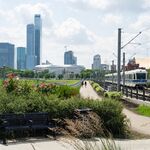CplKlinger
Senior Member
This is a bit off topic, but I love that the thread on 'suburban sprawl' is one of the least utilized threads in this forum. Much like lands used for suburban development...
Haha! I think the main reason is that (for the most part) suburban development is kinda boring and doesn't have much inspiration to it. You could either be in the far north or far south end of the city and you wouldn't be able to tell where you are! It's all just a sea of 2-storey houses, strip malls and low-rise buildings which look like massive housesThis is a bit off topic, but I love that the thread on 'suburban sprawl' is one of the least utilized threads in this forum. Much like lands used for suburban development...
Not Just Bikes' videos are sooo good! Always speaking straight facts about good vs. bad city designReally good video here. Anyone know if edmonton has public data on the tax revenues of different neighborhoods? Would love to see basically a revenue, expenses, net operating profit, debt, and capital cost/depreciation schedule breakdown.
The city should just put a "5% of total sale value" one time tax on all new builds outside the henday...
Totally. All my friends keep buying in edgemont for 350 cause they're nice new homes vs 400 for an older one that needs work closer to the core. But those prices don't reflect the true cost to the city. The city needs to give incentives to buy older homes in mature areas, or needs to create disincentives for new areas or the math will never add up!Not Just Bikes' videos are sooo good! Always speaking straight facts about good vs. bad city design
I agree, true incentives like what you mentioned for people to build within established areas and densify (like a bonus/relief on taxes based on how much density you add to an existing plot of land) would really encourage faster-paced change for the better.
I've done some quick searching through the City's open data, but have never been able to find anything that slices financials by neighborhood. I think it would be an incredibly important tool to have available though.Anyone know if edmonton has public data on the tax revenues of different neighborhoods? Would love to see basically a revenue, expenses, net operating profit, debt, and capital cost/depreciation schedule breakdown.
'give incentives'Totally. All my friends keep buying in edgemont for 350 cause they're nice new homes vs 400 for an older one that needs work closer to the core. But those prices don't reflect the true cost to the city. The city needs to give incentives to buy older homes in mature areas, or needs to create disincentives for new areas or the math will never add up!
Making private vehicle accessibility harder/more inconvenient is definitely a strategy to use in curbing car culture, but it can become the slipperiest of slopes if it isn't used in measure. If things go even just a little too far we could maybe see things going the exact opposite way, with traffic around the city getting worse and many people being upset/enraged and pushing for "Car Culture 2: Bigger & BadderTM" after the supposed "dark times". I'm not saying it would happen, but it's a possibility to keep in mindOh boy, yes the commuter/car culture here is so very strong.
I know I just said that incentives/disincentives on their own aren't effective, but In the context of transportation and curbing sprawl specifically, most of the research indicates that the only real way to reduce driving is to make it inconvenient and costly. Building the greatest transit system in the world won't convince people to use it if driving and parking is easy and cheap.
Not to plagiarize a certain mayoral candidate, but I think it genuinely is time for a "war on cars".





